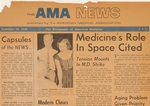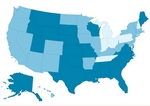business
$4 prescriptions cause electronic record headaches
■ A practical look at information technology issues and usage
By Pamela Lewis Dolan — covered health information technology issues and social media topics affecting physicians. Connect with the columnist: @Plewisdolan — Posted March 28, 2011.
- WITH THIS STORY:
- » External links
- » Related content
Patients taking advantage of $4 generic prescription drug programs may be helping their pocketbooks, but they're unwittingly hurting the cause of electronic prescribing and electronic medical records.
When insured patients buy prescriptions in the program, they generally pay cash to avoid using their plan, which usually carries a co-pay higher than $4. Because they are cash purchases, the only record of each transaction is the pharmacy's retail database, which usually isn't shared across the health care system the same way claims data from pharmacy benefit managers is.
The result: The record that a prescription was filled might not show up, creating incomplete records for other parties trying to track patient safety, quality control or research.
A New England Journal of Medicine report in November 2010 looked at issues caused by the lack of claims information created by $4 prescription programs.
"Because drugs are the most widely used medical interventions and are a cornerstone of the management of most chronic diseases, the consequences of these missing claims are not insignificant," the authors of the NEJM report wrote.
From a safety perspective, physicians will have incomplete lists of the medications prescribed to their patients by them and others, opening up the opportunity to prescribe something with a dangerous interaction. From a quality perspective, the data are important to researchers looking at drug efficacy and conducting comparative effectiveness studies and payers facilitating pay-for-performance programs.
The Healthcare Information and Management Systems Society's e-prescribing task force has been working to address issues presented in the NEJM report.
Michael Van Ornum, RPh, RN, a consulting clinical pharmacist who chairs the HIMSS e-Prescribing Task Force, said recently that as physicians adopt e-prescribing and EMRs, they are relying on the medication lists that those systems create to prevent dangerous medication interactions and duplicative prescriptions.
But what many physicians don't know is that those lists are not comprehensive, even when combined with pharmacy benefit manager data.
Niteesh K. Choudhry, MD, PhD, an associate physician in the Division of Pharmacoepidemiology and Pharmacoeconomics and the Hospitalist Program at Brigham and Women's Hospital in Boston, co-wrote the NEJM report. He said there are steps physicians should take to help ensure the safety of their patients -- with or without e-prescribing tools.
A patient's ability to pay for prescriptions is a conversation every physician should have with their patients, Dr. Choudhry said. They also should be aware of local pharmacies that have popular generic brands in the $4 programs. Some decision-support tools for prescribing will show physicians where the most affordable drugs can be purchased.
When a physician is aware that the patient might be taking advantage of one of those programs and paying for the drug in cash, it makes it even more important that the physician follows up with the patient to ensure that the prescription was filled and taken. Doctors also should ask about the medicines other physicians are prescribing.
Some e-prescribing systems are starting to take steps to try to eliminate the lack of communication.
The e-prescribing network Surescripts provides medication lists to physicians using their network that combine data from the physician's medication list, pharmacy records (which include cash-based purchases) and the PBM claims data.
Outside of those e-prescribing networks, the pharmacy transaction data that would include cash-based purchases often are unavailable to others. Some might report to e-prescribing networks and some might report to pharmacy benefit managers, but they might not report to both.
Dr. Choudhry said this problem needs to be addressed from a policy perspective.
"Pharmacies need incentives to submit such documentation, and these incentives must not violate conflict-of-interest and kickback regulations, given the established relationship between pharmacy benefit managers and pharmaceutical manufacturers," he wrote in the NEJM report.
The authors of the NEJM report suggest that a change is needed in the way data are collected. As more physicians adopt e-prescribing systems and EMRs, data could be harnessed from prescriptions written as opposed to prescriptions filled, they wrote. EMRs that can be integrated with PBM and pharmacy data and insurance claims hold promise as a rich source of information, Dr. Choudhry said.
Pamela Lewis Dolan covered health information technology issues and social media topics affecting physicians. Connect with the columnist: @Plewisdolan —












